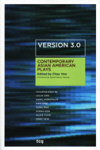Version 3.0
As explained in Version 3.0, the plays in this new anthology of Asian American drama are rarely produced outside of New York City and California. Yet they ought to be, as they encompass many cultures’ assimilation and conflicts with white culture. The anthology spans the generations from the Japanese internment years up to the multi-racial 2000s. The first wave of plays has common themes of “Asian American history and immigration, generational and familial conflict, cultural identity and nationalism.” The second wave further includes Chinese and Filipino playwrights, and the third those of Indian, Korean and Vietnamese descent. This last group, with l4% identifying themselves as “multiracial” in the 2000 census, says, “No single writer can represent an entire culture; only a community of writers can do that.”
As explained in Version 3.0, the plays in this new anthology of Asian American drama are rarely produced outside of New York City and California. Yet they ought to be, as they encompass many cultures’ assimilation and conflicts with white culture. The anthology spans the generations from the Japanese internment years up to the multi-racial 2000s. The first wave of plays has common themes of “Asian American history and immigration, generational and familial conflict, cultural identity and nationalism.” The second wave further includes Chinese and Filipino playwrights, and the third those of Indian, Korean and Vietnamese descent. This last group, with l4% identifying themselves as “multiracial” in the 2000 census, says, “No single writer can represent an entire culture; only a community of writers can do that.”
These plays, with their incredibly rich material to draw from, display a real sense of drama. They mix comedy, sadness and even horror and show inventiveness and experimentation. However, this non-Asian reviewer will select a few favorites I would like to see produced in the Midwest.
Alice Tuan’s “Last of the Suns” is one that shows real drama, employing a mixture of humor and horror. The central character is Yeh Yeh, a Chinese Nationalist army general “shriveling away under the harsh California sun as his failed ice-skating champion granddaughter Twila comes to visit him on his 100th birthday.” Tuan combines the real and fantastical, Chinese mythology and personal family history about her grandfather who was a lieutenant general in Chiang Kai-Shek’s Nationalist army and, when he was old, living with her family. The two fantastical/immortal characters Monkey King and Eight Pig almost serve as a chorus to the events. Tuan, as an American, says she was trying to “fuse contradictory old/new, East/West, male/female power,” and the latter comes out in Twila’s rejection of her mother’s pressure to become a world-class skater in favor of freedom:
It’s a family that smells stink mindlessly following and following . . . it’s a goddamned cult! . . . Tradition is a warp of reality.
Yeh Yeh has been ruthlessly cruel in his past power, which the two immortals recall, while Twila’s mother will never forgive her. Yet at the end Yeh Yeh is the only one to give Twila encouragement.
Diana Son’s “Satellites” is a microcosm of racist and sexual tensions. The title reflects the fact that “the characters are free-floating. A satellite is an entity that orbits around a larger entity; all of the characters lack a defining thing within their lives, so they end up colliding into each other.” Korean American architect Nina and her African American husband Miles move into a gentrified neighborhood of Brooklyn brownstones. A neighborhood black resident Reggie shows up when a brick is hurled through their window, offering deals on materials to upgrade and fix the property, offers which look suspiciously like thefts. Then Miles’ white hanger-on brother Eric shows up to stay and spin his wild schemes, also revealed for vengeful motives. In addition, the needs of the young couple’s infant collide with Anna’s architectural career, and even a hired Korean “grandmother” causes tensions. All these create a volatile combination under one roof. For instance, Miles says to his brother Eric:
You want what I have? Do you know what it is like. . . . that I don’t know what I pass on [to his baby Hannah]. Maybe there’s some disease. . . . Or maybe my great-grandfather was a Civil War hero . . .
At the end there is the beginning of a resolution with the explanation of the brick through the window as a “meteorite . . . crashing through here to let out all the ghosts, all the stories, all the history . . . To let us know . . . we can make up the words ourselves.”
The last clever combination of very short plays called “The Square,” written by different playwrights, includes a gem, Robert O’Hara’s “The Spot.” In it, a black woman and an Asian woman fight on the square for a spot to see Martin Luther King. The racism and sexism bring out obvious stereotypes, but then turns them on their head with three twists of the plot. An officer says:
We have to be able to infiltrate any group and bring back information on those white folks black folks yellow folks . . . and you have to be able to stand your ground when someone comes up to you . . . Some of them will be nice in one breath and sexual predators in the next . . .
In the very last play of “The Square” the title is realized as it is supplanted: “A new shape to learn . . . resee. Soften the corners. Round out the lines. Now let it be: Moon Park.”
This is an excellent anthology of new voices, which I hope to see in Midwest productions and not just limited to the coasts.





